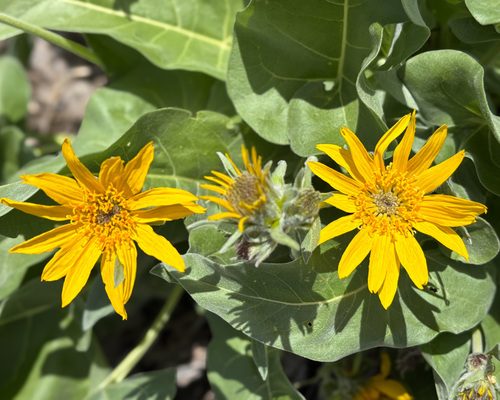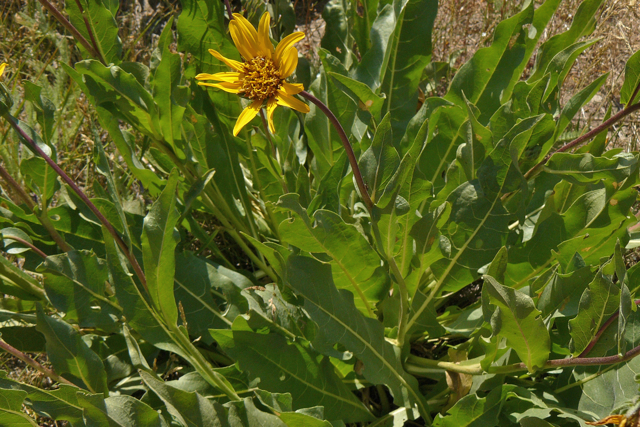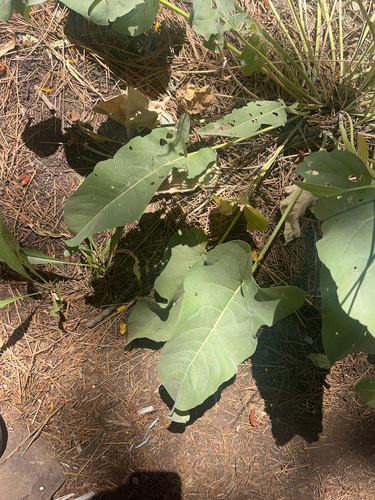Sun Seekers, Fire Carriers, and Medicine Keepers
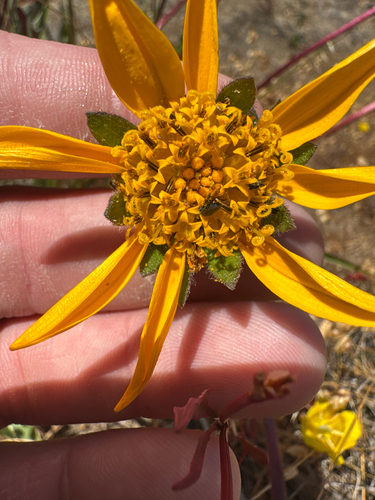
Mule’s ears (of the genus Wyethia) and arrowleaf balsamroot (Bupthalmium sagittata) are two flowering plants that to the untrained eye are so similar they are often mistaken for the other. Both herbaceous plants not only look very similar but are a part of the same family, subfamily, tribe and subtribe of plants. Further, genetic testing has confirmed that these two plants are the closest relative to one another. However, distinguishing characteristics do exist. Read on to learn about each plant and their unique place in the northern California biota.
Narrowleaf Mule-Ears (Wyethia angustifolia)
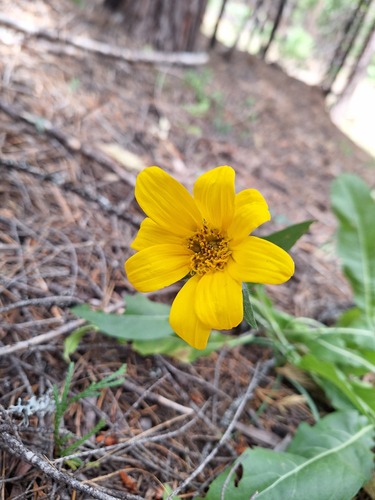
Wyethia is a genus of North American flowering plants in the family Asteraceae, more commonly known as the aster, daisy or sunflower family. Wyethia are commonly referred to as mule’s ears. The genus Wyethia can typically be identified by their leaves that connect to the base of the plant (basal leaves) and 1-2 ft tall flowering stalk with a sun-flower-like head. Most people would probably see this flower and call it a “native sunflower” because of its large yellow radial flower (or inflorescence). Other common names besides “mule’s ears” are “California compassplant” and “black sunflower.” In Yurok language they are called skep’ol, in Hupa they are called sa’liwh. The etymology of the name “compassplant” likely comes from the flower’s ability to track the sunlight through the day. The leaves are fuzzy or velvety and have a lance-shaped blade (long and narrow) which can distinguish it from its closest look-alike.
Photo: Narrowleaf Mule-Ears (Wyethia angustifolia). [Steven Clinton via iNatrualist]
There are several species of Wyethia [1], of these the most commonly found in the Klamath Mountains is Narrow Leaf Mule Ears (Wyethia angustifolia) which grows in stream banks and springs at elevations from 0-5,500 feet. You’ll typically see it flower in the spring to summer depending on its elevation. Mule’s ears also have a characteristically sticky milky sap that can be toxic to the touch when pruned or broken.
Arrowleaf Balsamroot (Balsamorhiza sagittata)
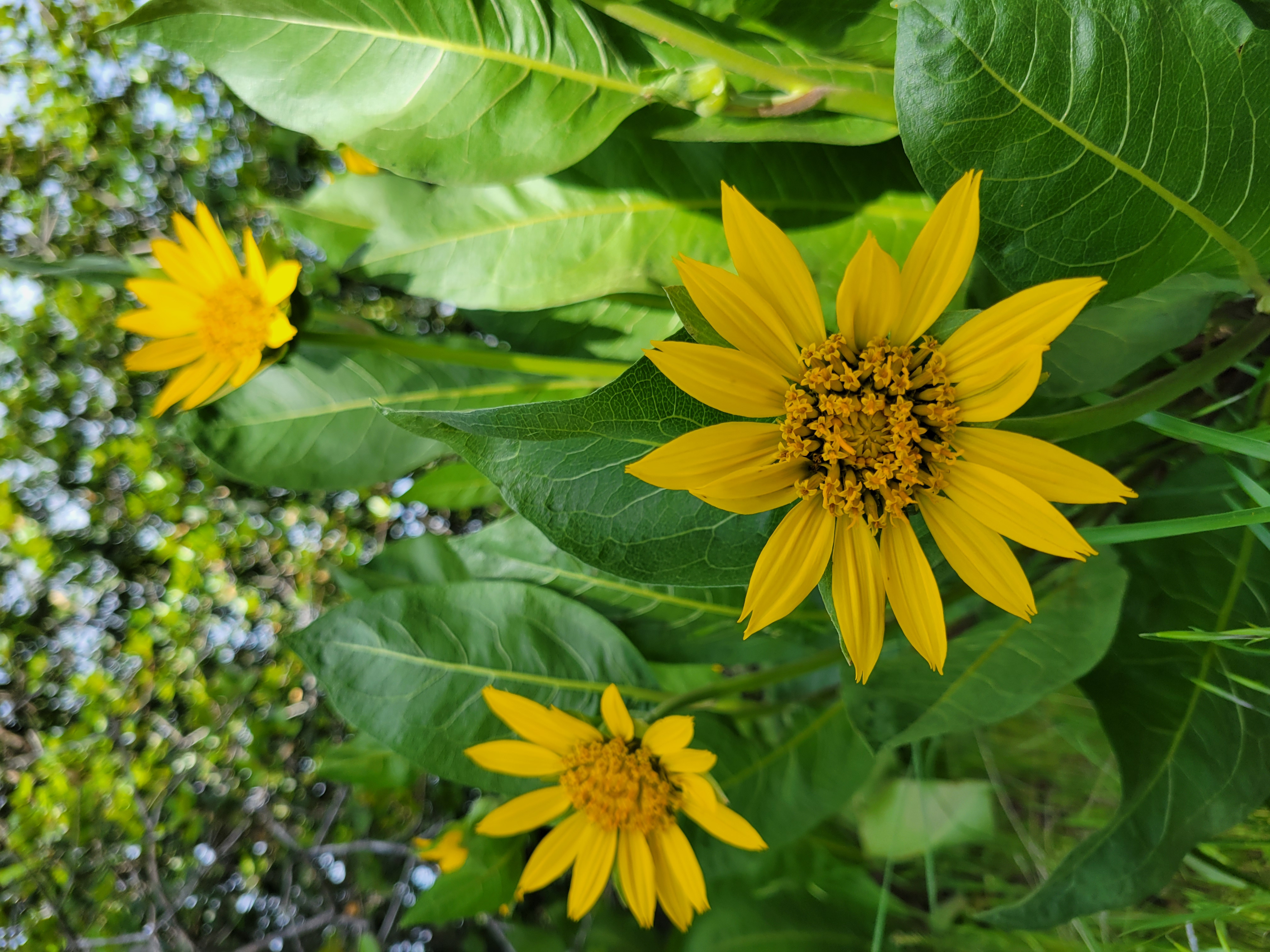
Balsamhoriza, otherwise called arrowleaf balsamroot, is also part of the Aasteracaea family. Arrowleaf balsamroot can be distinguished from mule’s ears when comparing the leaf shape, color and tiny hairs on the underside of the leaf. Arrowleaf balsamroot prefers colder and dryer climates and is found in mountain fields but can also be a common plant in the understory of conifer forests. It ranges from Colorado, west into the Sierra Nevada and north into Canada.
Photo: Arrowleaf balsamroot (Balsamorhiza sagittata). [Simone Groves, Hoopa Valley Tribal Fisheries]
Compare the two leaf systems in the below images.
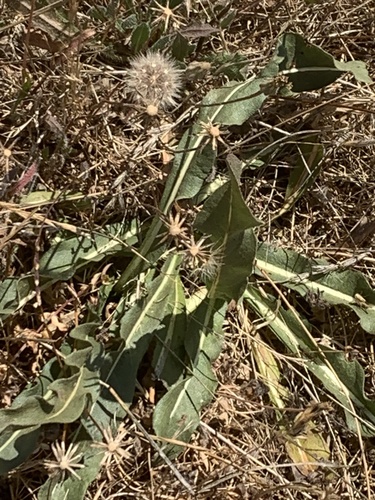
Similar to a turnip or a carrot, the roots of both mule’s ears and arrowleaf balsamroot have a long branching tap root in which the dormant plant resides during winter. The roots can penetrate over 6ft deep in the soil and spread 3-4 feet out away from the plant. Every year the vegetation dies back completely and will rise again from the earth in spring.
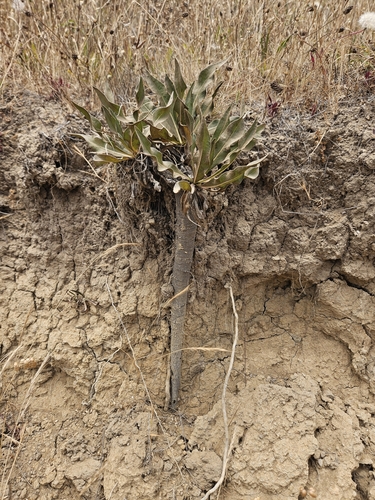
Mule’s ears occupy a range of vegetation types, including many arid and alpine communities whose habitat contains a mixture of dry-climate tree species and native grassland. These plants can handle harsh soil conditions, with very little topsoil and can be an indicator of disturbance activities, as their seeds germinate well in exposed soil. However, if an area is intensively grazed, these plants can be impacted. The young tender leaves of the plant in spring are sought after by ungulates and their populations can be eliminated by persistent grazing. Part of this is because they have dormant buds near the surface of the soil at ground level. If the shoot tips are eaten or damaged, the plant may be impacted.
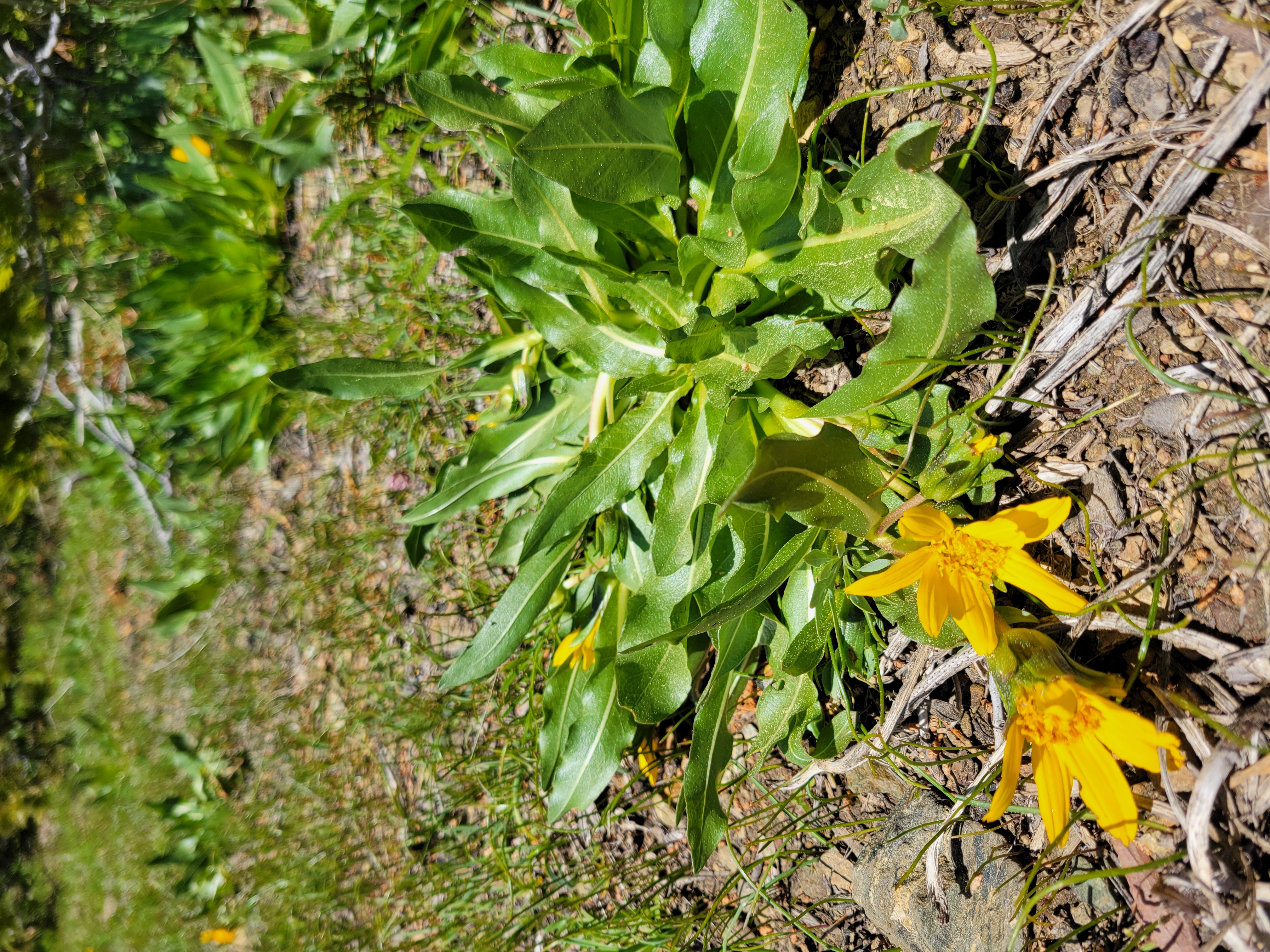
However, if populations establish, underground roots can be quite large and split multiple times which can allow new plants to form. This can form a circular patch radiating outwards from a central spot. The above ground portion of the plant dies back each summer and fall and the remaining dry material covering the ground can help carry the fire through patches of rock helping to gently move fire through an area. When the material burns, it adds a layer of ash to the soil, slowly accumulating topsoil and allowing new places for grassland to establish.
Shrubs that associate with a mule’s ears or arrowleaf balsamroot typically form fire risk patterns that are classified as a low-growing fuel class with a moderate to occasional high severity fire. Fires in these communities are often a “Fire Mosaic” where conditions result in a patchwork of burn severity between low and high severity depending on the fuel loading, and fire weather conditions under which it burns. The concept of a fire mosaic can be applied to much of California’s natural landscapes. Plant species throughout California, and the world, create specific fuel conditions through their physical bodies and life cycle strategies that often set conditions for the plants to return. In the dynamic interplay between life and death, growth and fire, persistent multi-generational patterns throughout history create these plant-and-fire relationships.
Mule’s ear and arrowleaf balsamroot are both very strong medicinal plants and are also used as a food source. Mule’s ear leaves have been used by the Miwok tribe to make a tea that helps to reduce fever and stimulate perspiration. The roots have been used to make a poultice which can reduce swelling, soothe burns, and according to Shishoni tribe – can be an “unfailing cure for syphilis” and wash made with the roots can be used to treat Measles. Today, places where these plants grow are considered medicine places and should be treated with respect. Various tribes document using the roots of the plants as one might eat Jerusalem artichokes, baked in an underground oven with warm rocks for several days.
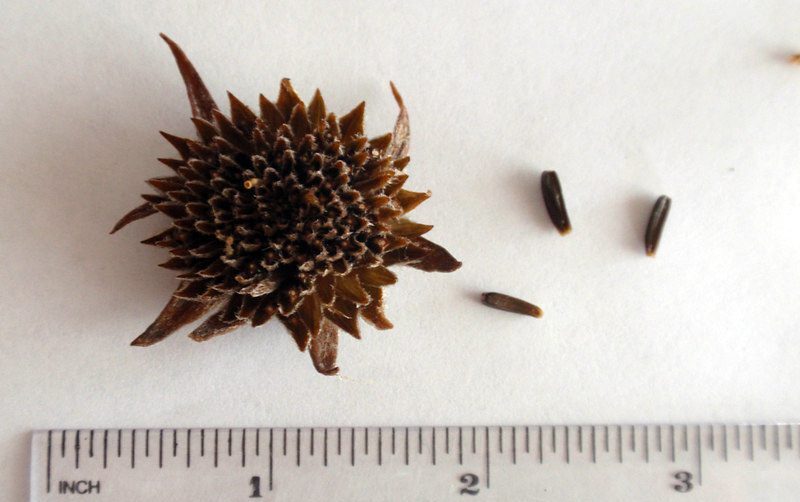
The large seeds produced by both plants are a favorite for birds and humans and are akin to sunflower seeds. There are several species of insects that use the developing seeds as a host plant and many different native bees such as megachile (leaf-cutter bee) species have a relationship with open pollinated flowers which can be very productive nectar producers. Open pollinated flowers tend to be the most frequently visited flower shapes because they provide a large landing pad and lots of space for pollinators to move around on them.
Photo: Arrowleaf balsamroot seed head and seeds. Photo USDI BLM OR030 SOS.
Mule’s ears and arrowleaf balsamroot are more than just striking wildflowers of the northern California landscape—they are living testaments to the deep interconnection between plant life, fire, wildlife, and human cultures. As food, medicine, and ecological agents, these plants reveal the intricate relationships that have long existed between people and place. Understanding their roles in ecosystem function and traditional knowledge invites us to view the land not as a backdrop, but as a living partner in our shared future.
Resources
- Wyethia – Wikipedia
- CalScape – Wyethia
- Wyethia angustifolia
- Native American Ethnobotany Database – Wyethia
- Native American Medicinal Plants: An Ethnobotanical Dictionary by Daniel E. Moreman
- Natural History Museum Data Portal: Wyethia
- FEIS USFS Database: Wyethia
- Reduction of Survival and Growth of Young Pinus jeffreyi by an Herbaceous Perennial, Wyethia mollis
- Impacts of Predispersal Seed Predation on Seed Production of Wyethia amplexicaulis, Agoseris glauca, and Crepis acuminata
- Wyethia on iNat
- Balsamorhiza on iNat
- Etymology online: Girasole
- Plant guide for arrowleaf balsamroot (Balsamorhiza sagittata)
Simone Groves, Riparian Ecologist, Hoopa Valley Tribal Fisheries
Simone is first generation California transplant of scottish descent raised in the unceded territories of the Raymatush in the rural west peninsula of the SF Bay where farmers, farm workers and hippies form the heart of the small town. She graduated in 2016 from Humboldt State University with a BS in Botany and has worked in the outskirts of rural Humboldt county on Natural Resource and Land management since 2013. She is passionate about plants and their interactions with dynamic systems as a mechanism for relearning our human-landscape interdependence.

